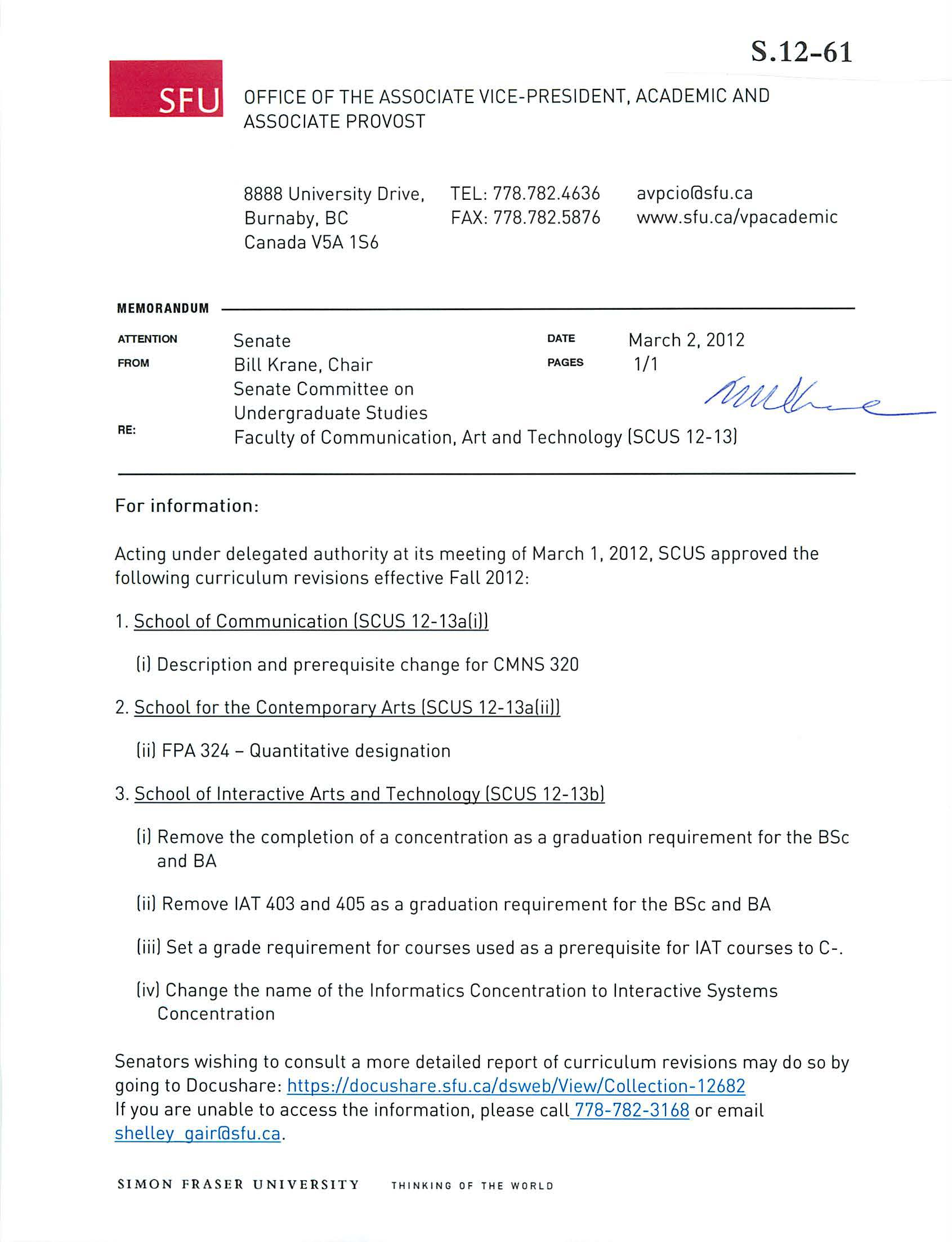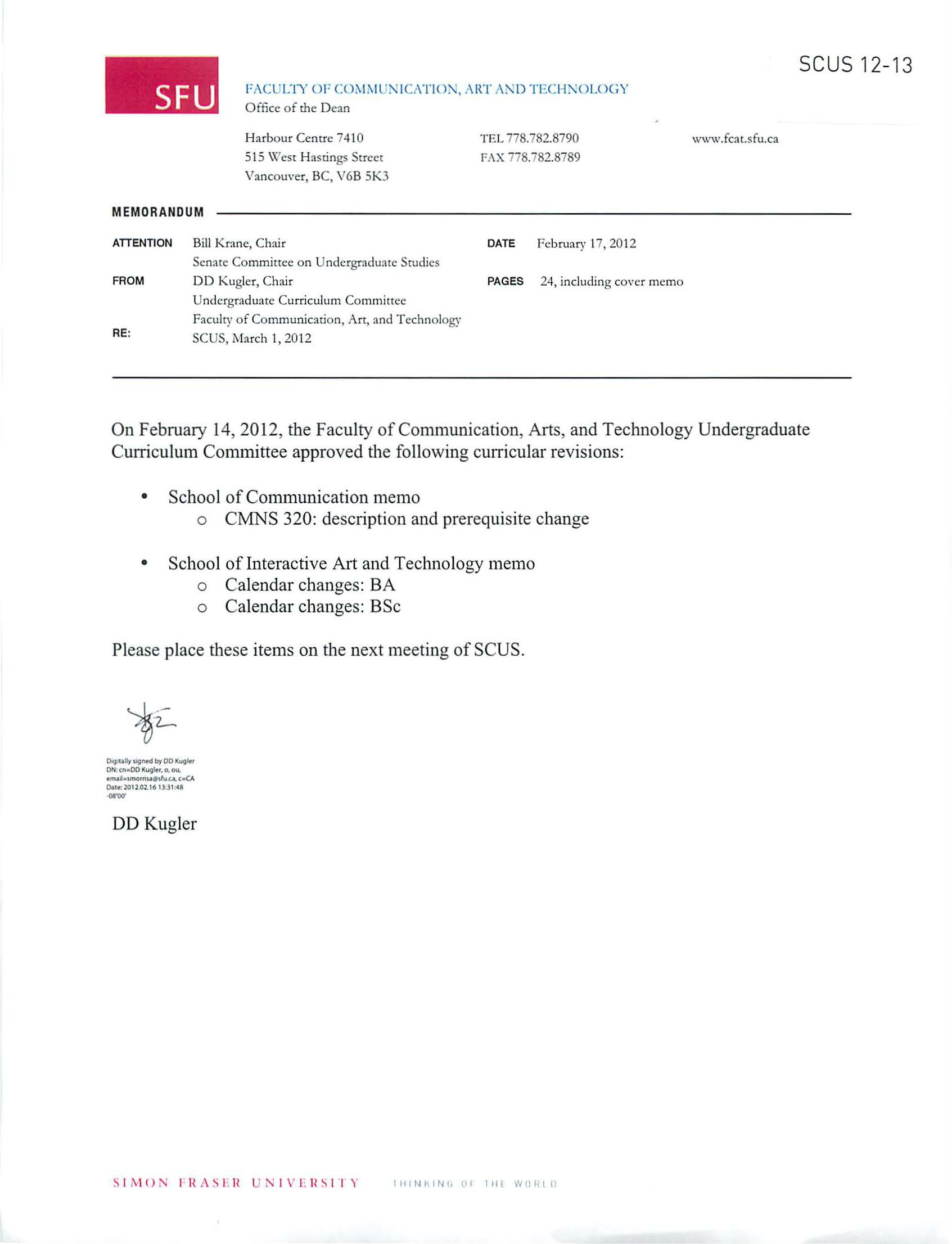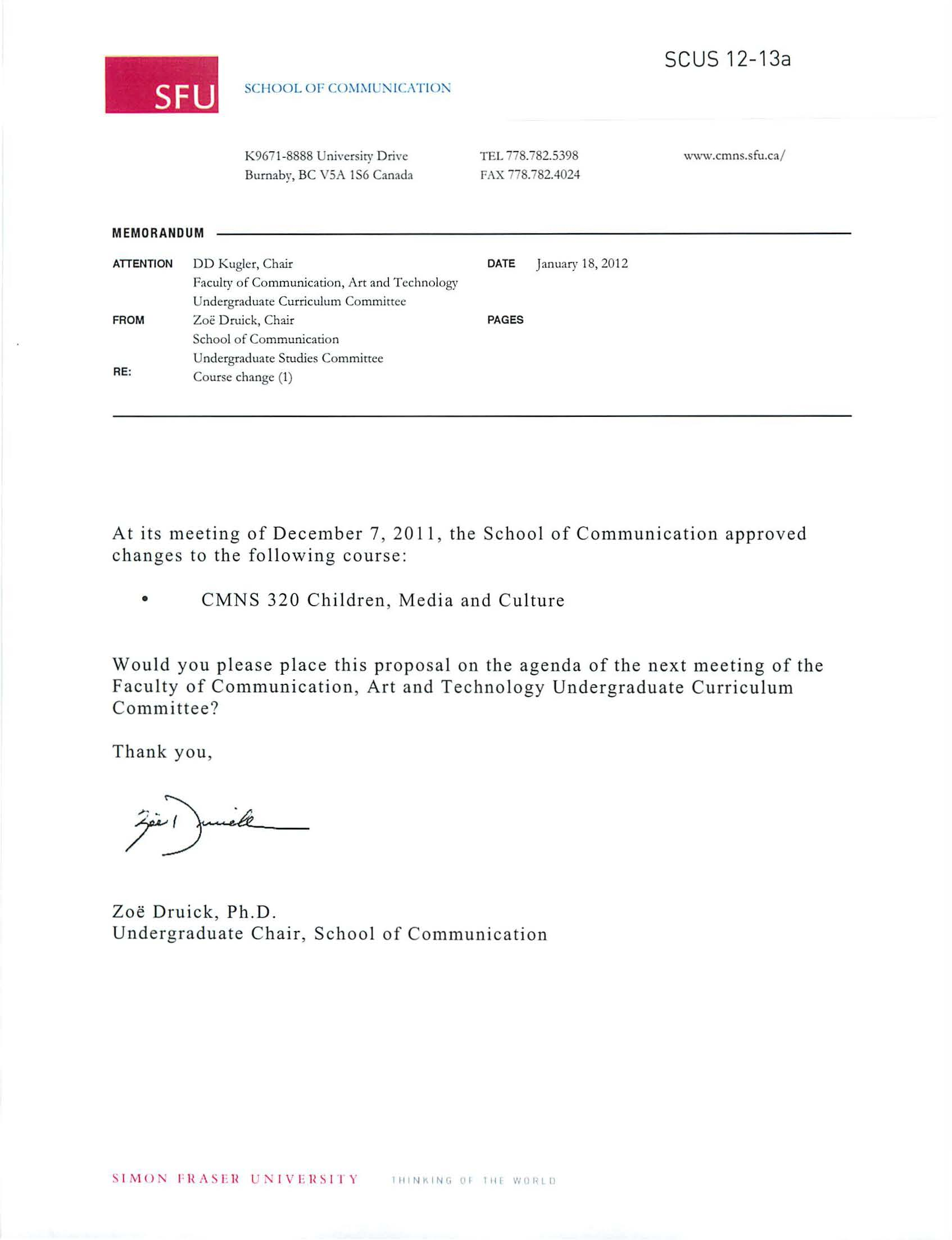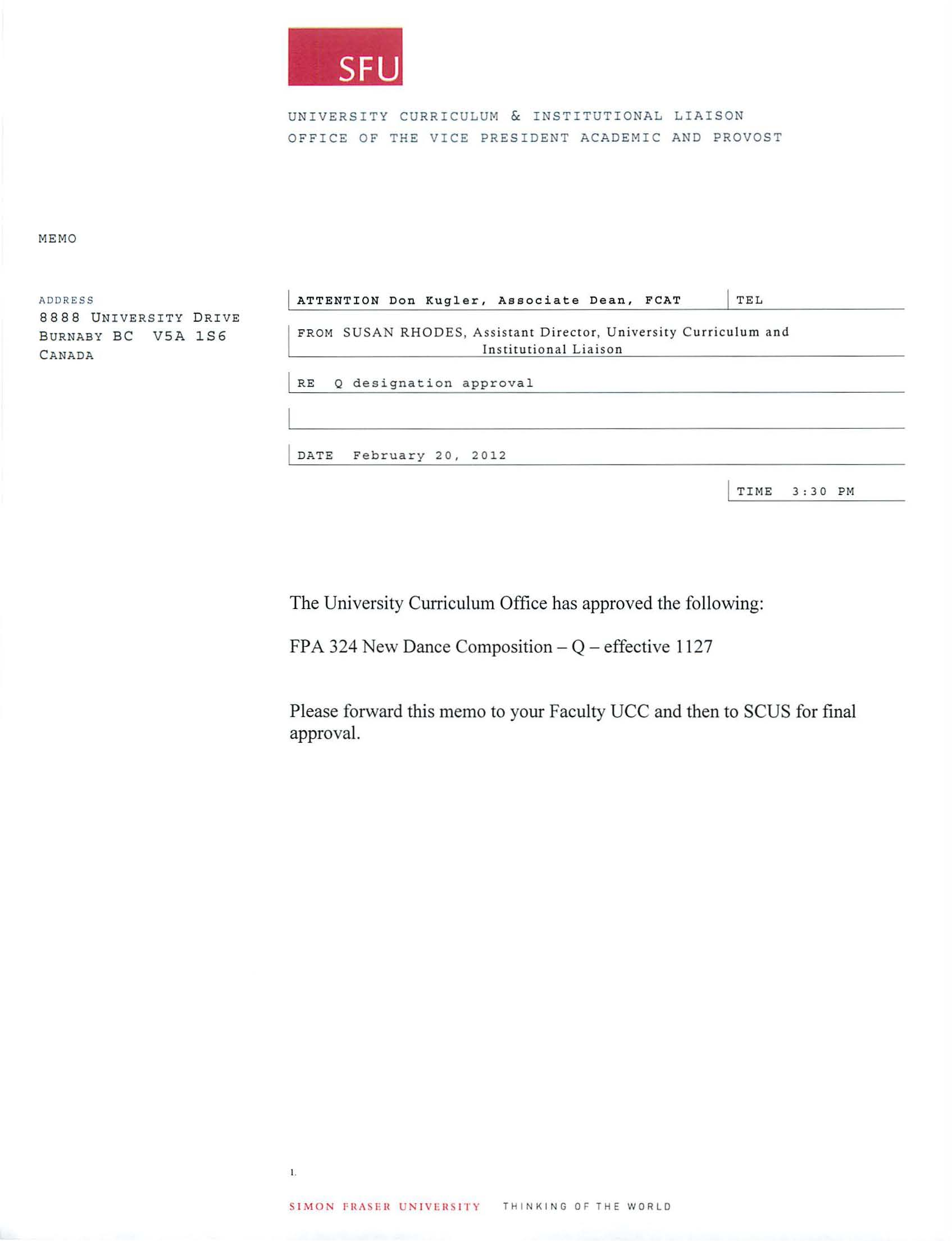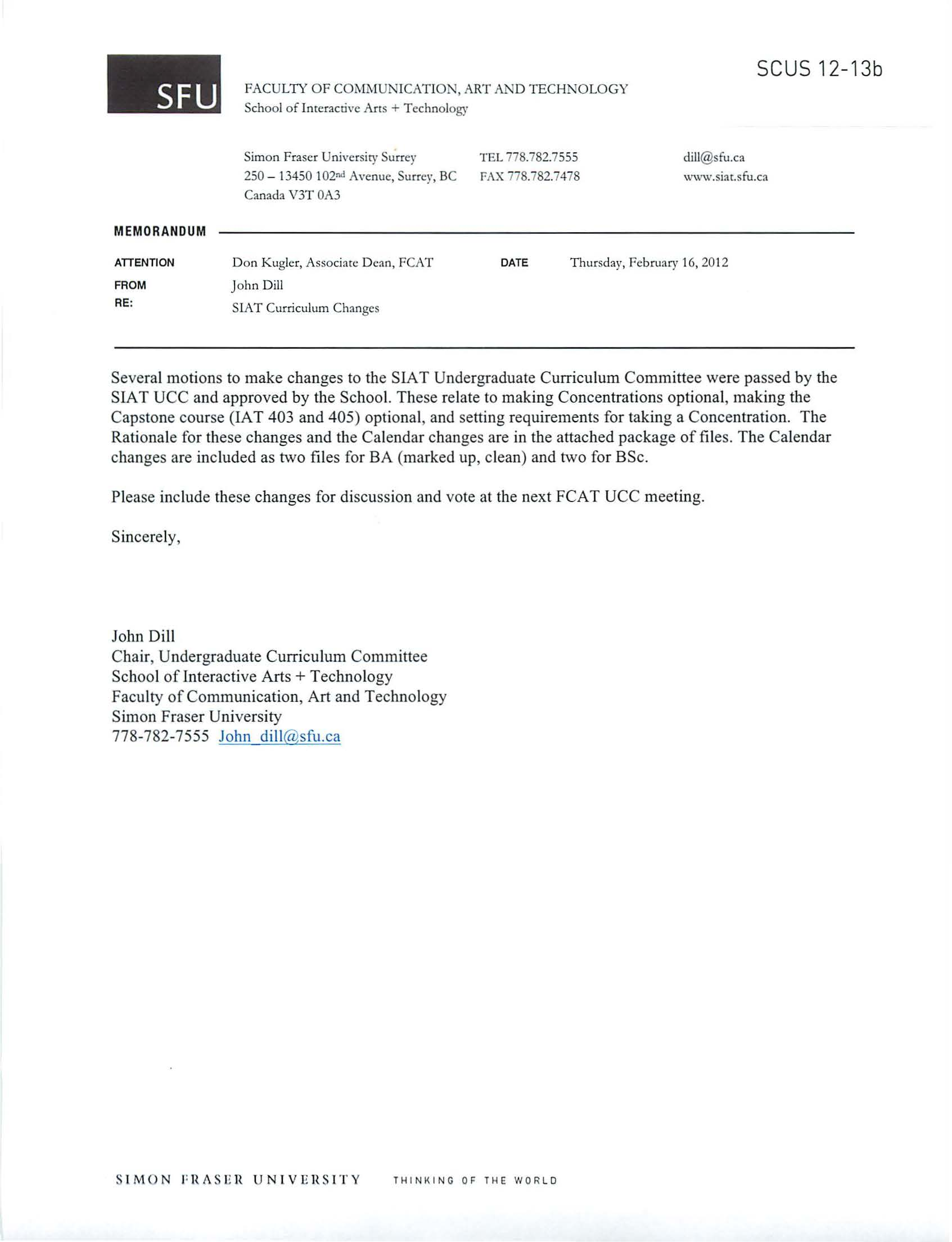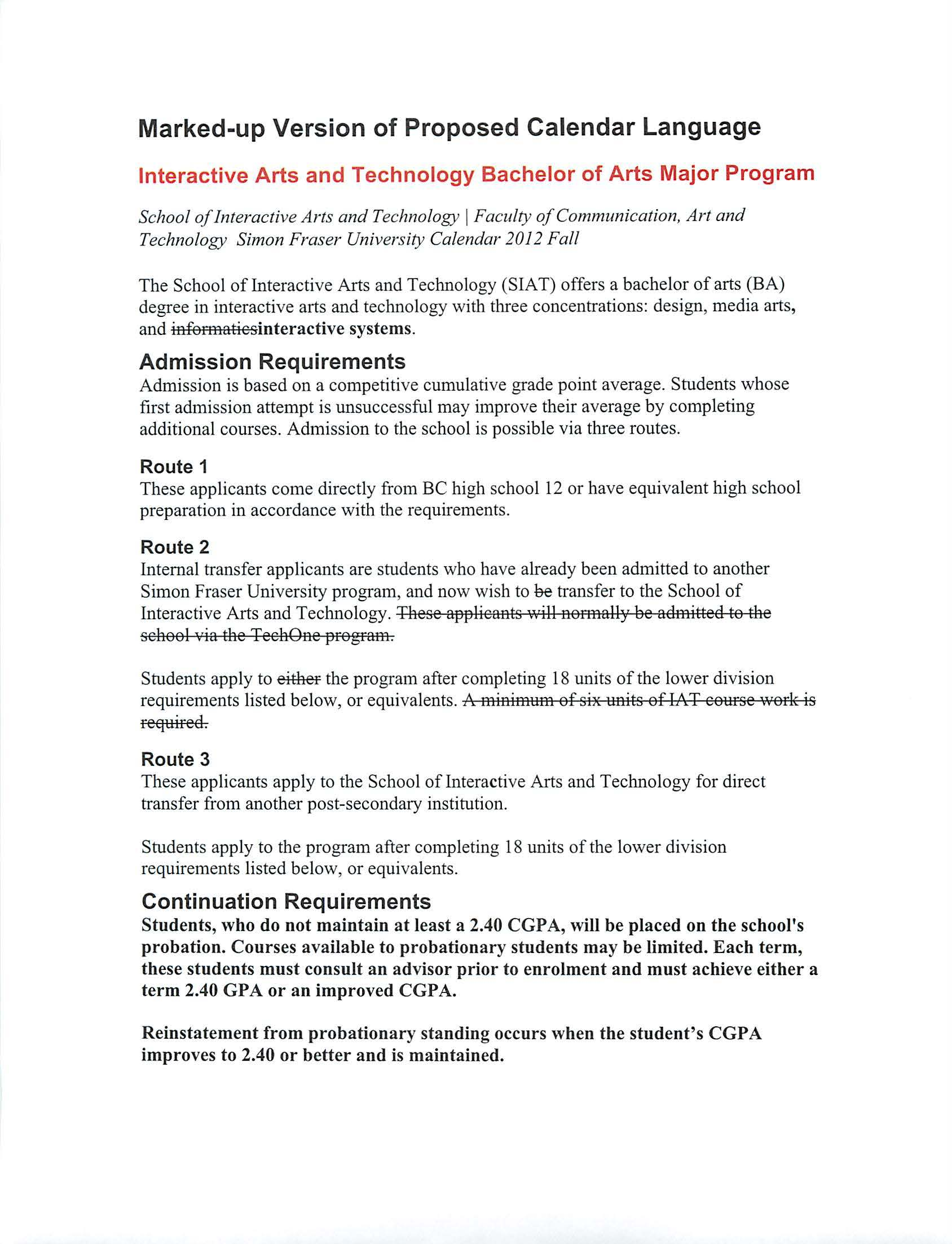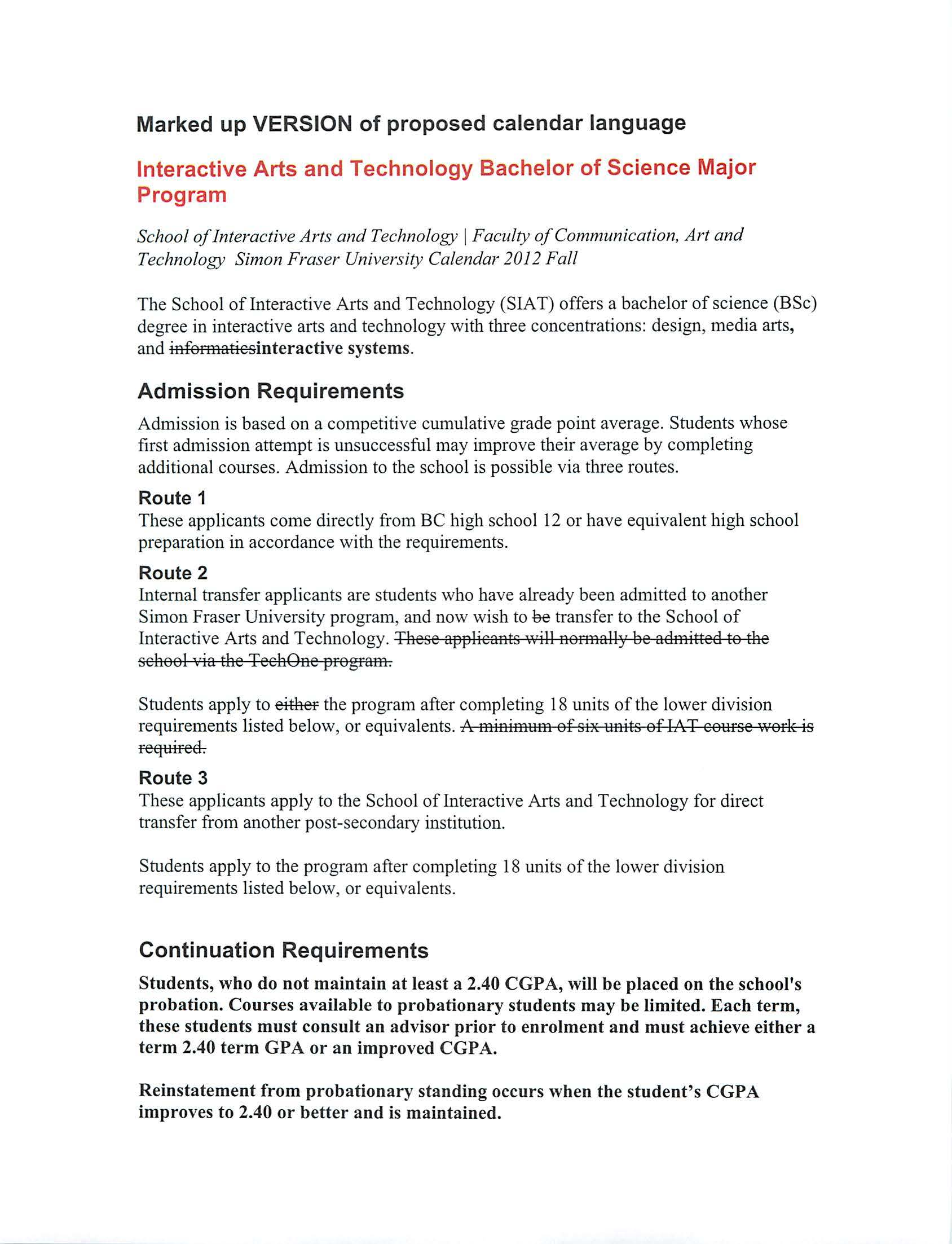S.12-61
OFFICE OF
THE
ASSOCIATE VICE-PRESIDENT, ACADEM
I
C AND
ASSOCIATE
PROVOST
8888
Uni
v
ersi
ty
Dri
v
e,
TEL
:
778.782
.
4
636
Burnaby,
BC
FAX: 778
.
782.587
6
Canada
V5A 156
a
v
pc
i
ofasfu
.
ca
www
.sf
u.
ca
/v
pacadem
i
c
MEMORANDUM
ATTENTION
FROM
Senate
Bill
Krane, Chair
Senate
Committee
on
Undergraduate Studies
DATE
PAGES
Ma
r
ch 2,
20
12
1
/
1
RE:
Faculty
of Communication
,
Art and
Technology ISCUS
1
2
-13]
For information:
Acting under
delegated
authority at
its
meeting of March
1,
2012, SCUS appro
v
ed
t
he
following curriculum
revisions
effe
c
tive
Fall
2012:
1
.
School of Communication
ISCUS 12-13alill
[i] Description and prerequisite change for CMNS 320
2
.
School
for
t
he Contemporary Arts
ISCUS 12-13a[iill
Iii] FPA
324- Quantitative
designation
3
.
School of Interactive Arts and
Technology [SCUS 12-13b)
lil
Remove
the completion of a concentration as a graduat
i
on
requirement for
the BS
c
and BA
Iii)
Remove IAT
403 and 405 as a graduation
requiremen
t
for the
BSc
and BA
[iii) Set
a
grade
requirement
for courses used as a prerequisite fo
r
IAT courses to C-
.
livl
Change the
name
of the Informatics Concentration
t
o
Intera
c
ti
ve
S
y
st
e
ms
Concentration
Senators wishing to consult a
more
detailed
report
of curriculum revisions ma
y
do so b
y
going to
Docushare:
https://docushare.sfu.ca/ds
web/View/Co
llection-12682
If
you
are unable to access the
information, please call
778-782-3168
or ema
i
l
shelley gairfasfu.ca
.
S
IMON
F
R
A
SER
U
NIVERSITY
T
HINK
I
NG O
F
T
HE
WORLD
F
ACU
LT
Y O
F
CO
:\I
~
I
UN
I
CA
TI
O~,
A
RT
A:-\
0
T
EC
H
~O
L
OG
Y
Office
of
rhe
D
ean
H
arb
o
ur
Ce
ntr
e
7
410
515
West
H
astin
gs
Street
V
anc
ou
,.er, BC
, V6
B
5K3
MEMORANDUM
ATIENTION
Bill
Kra
n
e, C
hair
Senate
Co
mmi
ttee on Undcrgradu:ue
Stu
die
s
FROM
DO
Kug
l
er,
Ch
air
RE
:
Undergraduate Curr
ic
ulum Committee
Facult
y
of
C
o
mmunicati
o
n
,
Art
,
and Technol
ogy
SCUS, i\
•
f
arch
I,
2012
TE
L
778.782.8790
r:Ax
778.782
.
8789
DATE
Fe
bru
ar
y
1
7,20
1
2
PAGES
24
,
incl
udin
g
co
ve
r
memo
scus
12
-
www.
fcat
.sfu.ca
On
February
14
,
20
1
2
,
t
he
Facul
ty
of Comm
uni
cation
,
Arts, and
Te
chno
l
ogy Undergradua
t
e
Curric
ulum
Comm
ittee
approved the
fo
ll
ow
in
g curricular
revi
sions:
• School
of
Communication memo
o
CMNS
320: de
sc
ription
and
prerequi
s
it
e c
han
ge
•
School of
Int
e
ractive
Art
a
nd
Technology
memo
o
Ca
l
enda
r
changes: BA
o
Calendar changes:
BSc
Plea
se
place these items on the next meeting
of
SCUS.
O.Ooully "')..., by 00 """'-'
OH
.
cn•OOKugt.r,o.ou.
•md ..
smomw
•
"uu.c
•
CA
Dil1r.l'OI2.1U
.
16
UJ141
-<OW
DO Kugler
)
1
,
\
I
ON
I
'
R
/\~1
H
UN
I\'LI!'-tl
l
Y
I Ill NI<INto
l>l
Ill I \'lOlli I
SCI
I
OO
L
or-
CO~
I
~
I
C:-.:IC\
TI
O:\
K
967
1-
8888 Un
i
1.ersity
Dr
i1
.
e
Burnaby,
BC
VSA
IS6
Canada
MEMORANDUM
ATTENTION
DO Ku
gle
r
, C
h
air
FROM
RE
:
Faculty
of Co
mmuni
ca
ti
o
n
, t\rt
and T
ec
hnol
ogy
Under
gr
aduate
Curric
ulu
m Comm
itt
ee
Zoe
Druick, Chair
School of Com
munica
tion
U
nd
e
r
g
r
a
d
ua
t
e
Srudies
Co
mmirr
ec
Cou
r
se
change
(
I
)
TE
L
778.782.5398
Fr\X 778.782.4024
DATE
Jan
u
a
r
y
1
8,
2012
PAGES
SCUS12-13a
11.ww.cmns.sfu.ca
/
At it
s
meeting
of
Decemb
er
7
,
20
11
,
the Schoo
l
of Communication approved
changes
to the following
co
ur
se:
•
CMNS 320 Chi
ldr
en
,
Media and
C
ulture
Wou
l
d
yo
u pl
ease
place
thi
s
prop
osa
l
on
the
agenda of
th
e
ne
xt
m
eet
in
g
of the
Facu
l
ty
of Co
mmunication
,
Art and Techno
l
ogy
Under
gradua
t
e Cur
ri
cu
lum
Committee
?
Thank
yo
u
,
Zoe
Dru
i
ck
,
Ph.D.
Und
e
rgraduate
Cha
ir
,
Schoo
l
of
Co
mmuni
cat
ion
S
I
~
I
0
:'\
I
'
H
1
\
S
I
H
L
"
:'\
I
\'
I H
S
I
I
\
I
Ill
N
1\
I
N
u (ll I
II I
\'/ () Ill ll
SIMON FRASER UNIVERSITY
Course Change Form
Existing Course Number:
CMNS ...:.3=2:..:.0 __
Credits: __ 4"-
Existing Course Title:
Children, Media and Culture
Please
check
appropriate
revision(s)
being
recommended:
Course Number:
Credit Hour:
Title:
Description:
__ x_
Prerequisite:
_x __
(Note: Each revision being made must have appropriate "from", "to", and "rationale" sections completed below. Use additional pages
if
necessary.)
Rationale:
Rationale:
The course examines the part played by communication media in children's lives by
reviewing the debates and research in this field. Specific attention will
be paid to the
issues
of violence, literacy, imagination, quality and marketing through an
examination
of the critical writing and advocacy movements which have arisen
around the problem
of children's media.
A historical exploration
of the role of communication media in children's lives
focusing on the growing public debates about children's cultural industries (toys;
comics; films;
TV and video games) and the role they play in consumer socialization.
Description brought in line with current course content
60 units including two of CMNS 220, 221, 223, 226. Strongly recommended: CMNS 362 or 363.
60 units including two of CMNS 220, 221, 223 or 223W, 226.
To eliminate
3rd
year pre-reqs for another third year course.
Does this course duplicate the content of a previously approved course to such an extent that students should not receive credit for both courses?
If
so, please specify.
Effective date:
Approvals:
Alison Beale, Director
School of Communication
date
l\I&J
I
0 11
~A
1-\...
.Z.o \ .Z
Chair, Faculty of Communication, Art
&
Technology (FCAT)
Undergraduate Curriculum Committee
date
Chair
scus
date
MEMO
ADDRESS
88
8
8 UNIVERSITY
D
RIVE
BURNABY BC
VSA
1 S 6
CANADA
UNIVERSITY
CURRICULUM
&
INSTITUTIONAL LIAISON
OFFICE OF THE VICE PRESIDENT ACADEMIC AND PROVOST
ATTENTION Don Kugl
e
r, Associate Dean
,
F
C
AT
TEL
F
ROM SUSAN RHODES
,
Ass
i
sta
n
t D
ir
ector
,
U
n
iversity
Curricu
l
um a
n
d
Institut
i
ona
l
Liaiso
n
I
R
E
Q designation approval
I
DATE Febr
ua
r
y
20,
2012
I
TIME
3
: 3
0
PM
T
h
e Univer
s
it
y C
urri
c
u
l
um Offic
e
h
as ap
p
rov
ed th
e
f
o
ll
ow
in
g
:
F
P
A 32
4
New
Dan
ce
Co
mp
os
iti
o
n
-
Q
-
effect
i
ve
1
127
P
l
e
ase
f
or
war
d
thi
s
m
emo
t
o
y
our
F
a
c
ul
ty UCC an
d
t
h
e
n
to SCUS
f
o
r final
appr
ova
l.
L
SI.\10N FRASIII
UN
IVLI~
S
n
Y
THI
NK
I
N
G
O
F
T
H
E
WORLO
MEMORANDUM
F
A
C
U
LTY
O
F
CO~
!
~
!
UN
I
CA
TI
O
, A
RT
AN
D TE
C
H
NOLO
G
Y
Sc
h
oo
l
of
lm
c
r
a
cri
vc Art
s
+
T
ec
hn
o
l
o
gy
S
im
o
n Fra
s
er
U
n
ive
r
s
i
ty Su
r
rey
2
5
0
-1
3
45
0
1
02
nd
Ave
n
ue, Su
rr
e)
'
,
B
C
Ca
n
a
d
a V
3T
O
A
3
TEL 778.782
.
7
555
l'
i
'u\:
778
.
782
.
7
4
78
scus
1
2
-
13b
dill
@
www.siar.sfu.ca
ATIENTION
FROM
D
o
n
Ku
g
ler,
A
s
s
o
ci
a
r
c
De
a
n
,
F
CA
T
John Dill
DA
T
E
Th
u
r
s
da
y
, F
e
b
ruary
1
6, 2012
RE
:
S
IA
T
C
u
rriculum Chan
ges
Seve
r
al
mo
t
io
n
s
t
o make c
h
a
n
ges to the SlAT Undergraduate Curricu
l
um Committee were passed by
t
he
SlAT UCC a
n
d a
p
prove
d
by
th
e Schoo
l.
T
h
ese
r
e
l
ate to ma
kin
g Concen
t
rat
i
ons
optio
n
a
l
,
making t
h
e
Caps
t
one
cou
r
se
(lA
T
403 and 405) optio
n
a
l
,
a
n
d setting
r
equi
r
ement
s
for
taking
a Concentrat
i
on.
The
Ratio
n
a
l
e
fo
r
t
h
ese changes an
d
t
h
e
Ca
l
e
n
dar c
h
ange
s
are
i
n the attached package of fi
l
es.
T
h
e
Calendar
cha
n
ge
s
are
in
c
l
uded as two
fi
l
es fo
r B
A
(ma
r
ked up
,
clean) and two fo
r
BSc.
P
l
ease
i
nc
l
ude
th
ese changes fo
r
di
s
c
u
ssio
n
a
nd
vote at
t
he
n
ex
t
FCA T
UCC
m
eet
in
g.
S
i
nce
r
e
l
y
,
Joh
n
D
ill
Chair
,
Undergraduate C
u
rricu
l
um
Committee
Schoo
l
of Inte
r
act
i
ve
Arts+ Tec
h
no
l
ogy
Facu
l
ty
of Comm
u
nicat
i
o
n
,
Art
and Tech
n
olog
y
Simon Fraser
Un
i
v
e
r
s
i
ty
77
8
-7
8
2-7555
J
o
hn
dill
@
s
fu
.ca
S
I
M 0 N
1
:
n
/\ S
E 1l UN
I
VE
n
S
I
T
V
THINKING OF THE WORLD
Rationale for proposed
SlAT
Curriculum changes
John Dill
6 Feb 2012
These changes were approved at the Dec 2011 and Jan 2012 SlAT UCC meetings and at the School meeting of 25 Jan 2012.
Remove requirement for concentration
SlAT currently requires completion of a concentration (consisting of a set of 6 required courses) in one of three areas. The original
intent was in part to accommodate the transition from a TechBC-based program and envisioned an approximately equal distribution
of students across concentrations. The transition is now complete and the equal distribution assumption has proven inaccurate.
Further,
eliminating the concentration requirement removes barriers to timely completion while preserving the same rigorous
requirements
for the SlAT BA or BSc major.
Thus, concentrations are
available but not required. Additionally, due to resource limitations, it is necessary to provide a mechanism
to cap the number of students in concentrations.
Motion approved
at School Meeting:
To remove the completion of a concentration as a graduation requirement for BSc and BA in Interactive Arts and Technology,
and
to establish a mechanism for preferential enrollment into concentration courses for students accepted into a concentration.
Acceptance
to a concentration will be based on the student's CGPA at the time of application to the concentration of choice.
Make Capstone course optional
SlAT's capstone course was originally intended as an opportunity for students from mixed backgrounds to work as a team on a
substantial project.
As SlAT has evolved, accommodating all students is straining our resources, while other team project
opportunities have arisen. Making
the Capstone optional will support those students wanting to engage in a large 2-semester
project course,
while offering an opportunity for others to pursue subjects of interest.
Motion approved at School Meeting:
To remove IAT 403 and IAT 405 as a graduation requirement for BSc and BA programs in Interactive Arts and Technology.
Set performance expectations
Establishing a minimum CGPA for continuing in SlAT will improve class quality, decrease graduation time and improve School ratings.
A minimum
CGPA of 2.40 is a common requirement in other majors and guarantees a minimal level of knowledge and skills to
successfully progress through the SlAT curriculum. A one year transition period will be provided for students to meet this
requirement.
Additionally, setting a minimum grade requirement for prerequisite courses will help ensure a minimal level of
prerequisite knowledge to improve the chances for success in the given course. This is done in other SFU majors.
Motions approved
at School Meeting:
To set the continuation CGPA requirement for SlAT majors at 2.40
To set the grade requirement for courses used as a prerequisite for IAT courses to "C-".
More meaningful name for Informatics concentration
While courses in this option are well-populated, there is a general lack of understanding of what the concentration means among
students considering
SlAT, among Coop personnel, industry, and others. Many of the faculty associated with the concentration have
felt a more appropriate name would help attract more of the kind of students we'd like to have in SlAT.
"Interactive Systems"
communicates the content of the concentration better and will be recognized by all stakeholders.
Motion approved at School Meeting:
To change the name of the Informatics concentration to
1
'lnteractive Systems"
Calendar Changes
The above motions require changes to the basic Calendar descriptions for SlAT's BA and BSc programs. The changes are described in
documents
included in this package. There are two documents for each of BSc and BA programs:
• a "marked up" version (insertions are bolded; deletions are indicated by a strike-through).
•
a "clean" version.
We would
like these changes to become effective in Fall 2012.
1
Rationale for Calendar Changes
Marked-up Version of
Proposed
Calendar Language
Interactive Arts and Technology Bachelor of Arts Major Program
School of
Int
e
r
act
i
v
e
Arts
and T
e
chno
l
ogy
I
Faculty
of Communication, Art
and
T
echno
l
ogy
S
imon
Fraser University
Ca
l
endar 2
01
2
F
al
l
The
School
of
Int
e
racti
ve
Arts
and Technology
(SlAT)
offers a
bachelor
of
arts
(
BA
)
degree
in interacti
ve a
rts
and
t
echno
l
ogy
with three concentrations:
de
s
ign
,
media
arts
,
an
d informaticsinteractive systems
.
Admission Requirements
Admission
i
s
ba
s
ed
on
a co
mpetiti
ve
cumulative grade
p
o
int
average. Students whose
first
admi
ss
ion attempt i
s
un
s
ucc
ess
ful ma
y
impro
ve
th
eir aver
age b
y
completing
additional
c
ourses.
Admission
to the
school
is po
ss
ible
via
three routes
.
Route 1
These
applicants come
directly
fro
m BC
high
sc
ho
o
l 12
or
ha
v
e
e
quiv
a
lent high
scho
ol
prepar
a
tion in
accordance
w
ith the r
e
quir
e
m
e
nts
.
Route 2
Internal
transfer
appli
can
t
s
are
s
tudent
s w
h
o
h
ave
already
b
ee
n
admitted
to anoth
er
Simon Fraser University
progr
am, an
d no
w
wish
to
oo
tr
ansfe
r to the School
of
Interacti
ve
Arts
and Te
c
hnology.
These
applicants ..vill n
o
nnally be admitted to the
school via
the TechOne program
.
Stud
e
nt
s a
ppl
y
to
ei-tflef the
pro
gra
m
after
co
mpleting 1
8
unit
s
of th
e
low
er
divi
s
ion
requirements
listed below
,
or
equivalents. A minimum
of siJ(
units
ofiAT
course
vrork
is
required
.
Route
3
Thes
e
applicants apply
to the Sch
o
ol of Int
e
r
a
cti
ve
Art
s
and
Technolo
gy
for dire
c
t
transfer from another post-second
ary
institution.
Stud
e
nt
s
apply
to th
e
program
after
co
mpl
et
ing
18
unit
s
of
th
e
lo
we
r di
v
i
s
ion
r
e
quir
e
m
e
nt
s
listed b
e
low
,
or equivalents.
Continuation Requirements
Students, who do not maintain
at
least
a
2.40
CGPA,
will be placed on the school's
probation. Courses
available
to probationary students ma
y
be limited. Each term,
these students must consult an advisor prior
to enrolment
and must
achieve
either a
term 2.40 GP
A
or an improved CGP
A.
Reinstatement from probation
a
ry
standing
occurs
when
the student's CGP
A
improves
to
2.40
or b
e
tter and is maintained.
Prerequisite Grade Requirement
Interactive Arts and Technology course entry requires a grade of C- or better in
each prerequisite course.
Students must obtain permission from the department
if
they wish to complete, for
further credit, any course
that is a prerequisite for a course the student has already
completed with a grade
ofC- or higher.
Program Requirements
This program requires the completion of
... lo';;er division requirements of 12
liBi~s
of apJ3roved
flfs~
year eolifses and the
SL'\T eore
reql.tiremeftts
... Uflfle£ division requirements of M
leas~
one of tfte !JH:ee
eoneenka~ioas
ifl
SlAT
• lower and upper division requirements of the BA degree program as specified
below
• a total of 30 lA T upper division units
• a total of at least 120 units including 45 upper division units.
Smden~s en~er
tftis major J3Fogram ey meeting the admission requirements Sfleeified
aeove. Sftldeftts ..viii noffBally a}3}3ly
~0
tfte Bl'\ J3f0gfaftl after
eomJ3le~ion
of
fiTs~
year
smdies or equi
7
raleat.
Lower Division Requirements
The
firs~
year of a degree in
IB~erae~ive
Arts aad Teelmology is TeehOne, y;ftieh is
eom13rised ofCMPT lee, IA:T 100, 102, 103
1
.l!, lOa, le7, aad eitfter MATH 130 (B:PL) or
~41\CM
101 (BSe).
Core Courses
SIA T lower division core requirements are as follows.
Students complete all
of
• CMPT 166-3 An Animated Introduction to Programming ( or an equivalent
introductory programming course such
as CMPT 120, 125, 126, or 128)
• IA T 100-3 Digital Image Design
• IAT 102-3 Graphic Design
• IA T 1 03W -3 Design Communication and Collaboration
• IAT 106-3 Spatial Thinking and Communicating
• IAT 167-3 Digital Games: Genre, Structure, Programming and Play
• IA T 201-3 Human-Computer Interaction and Cognition
*
• IAT 202-3 New Media Images
• IAT 222-3 Interactive Arts
• IA T 233-3 Spatial Design
• IA T 235-3 Information Design
• lA T 265-3 Multimedia Programming for
Art
and Design
*
(or other approved
second year programming course )
• IAT 267-3 Introduction to Technological Systems •
*these courses or their equivalents must have a science designation
Additional Requirements
Students
in
the BA program will also complete both of
• IAT 206-3 Media Across Cultures
• MATH 130-3 Geometry for Computer Graphics
Upper Division Requirements
A major in Interactive Arts and Technology comprises 30 units of upper division
lA T courses. These may include courses listed in the next section. Directed study
and field school courses are not counted as part of the major requirements and are
considered electivesl\
Bl\
v;ith a majef is ef:feFed v;ith three eeaeeM.ratieas: design,
media arts, iafeFmaties
(see belev:). All share the :fuadameBtal eeaeem ef f)eef)le usiag
teehaelegy ia eeBtext. Baeh dfav:s from distiBet f)attems ef sehelarshijl aad thiBkiBg.
Eaeh has
its ev!B aeademie emf)hasis leadiag direetly te its f)artieular f)attem ef smdy aad
gmdtiate euteeme. Smdeats must eeffif)lete the liflfleF divisiea Fef}liiremeats ef at least eae
efthe thfee eeaeeM.ratieas iB SIPJ .
.a Ceaeeatfatiea ia
~4edia
A:rts
.a Ceaeeatfatiea iB IBfeFmaties
.a Ceaeeatfatiea iB Design
AEIEiitieAal
RequiFeFReAts
Students
in
this BA program will
alse
complete aeth ef
.a LAa:T 4 03 3 lBtefdiseif)liaary Desiga St1:1die I 0"L-ts)
.a IPa:T 4 05 3 lateroiseif)liBary Desiga Smdie II (zA.rts)
ftHEi 24 units chosen from the following list:
• IAT 312-3 Foundations of Game Design
• IAT 313-3 Narrative and New Media
• IAT 320-3 Body Interface
• IAT 334-3 Interface Design
• IAT 338-3 Interactive Objects and Environments
• lA T 343-3 Animation
• lA T 344-3 Moving Images
• IAT 380-3 Special Topics in Interactive Arts and Technology (Arts)
• IA T 431-3 Speculative Design
• IA T 443-3 Interactive Video
• IAT 445-3 Immersive Environments
• IAT 480-3 Special Topics in Interactive Arts and Technology (Arts)
• any upper division course from communication (CMNS), publishing (PUB),
cognitive science
(COGS), contemporary arts (FPA), human geography (GEOG),
philosophy (PHIL), business (BUS), or psychology (PSYC).
Concentrations
A concentration is an area of specialization that approved lA T majors may pursue
within their Bachelor of Arts.
Students may choose their area
of concentration after completing at least 27 units of
lower division core courses. All upper division
(300
&
400 level) concentration
courses must be completed
at SFU.
Areas of concentration are only open to approved lA T majors. Students pursuing
an
lA T minor may not pursue an area of concentration. Acceptance to some
concentrations
is limited due to the limited spaces in required courses; students
will
be accepted to these limited concentrations based on their CGP A and are required
to maintain the specified CGP A while pursuing the limited concentration. Students
can be accepted only to one concentration
at the same time. Students in a
concentration have priority in registering for
that concentration's courses. Students
are required to complete all their concentration courses within two years, after this
time they
will
lose their priority for registration in concentration courses.
Students who do not choose a concentration or are not accepted to any
concentration may still complete concentration requirements and apply for
recognition of the completed concentration on their degrees at the time of
graduation.
Students may complete more than one concentration. All completed concentrations
will
be recognized on their degrees.
Concentration in Media Arts
This concentration studies the creation, analysis and understanding of new media. New
media environments are both computational artifacts and cultural experiences that include
historical, social, aesthetic, and economic processes.
Graduates will be skilled in the critical analysis and making
of new media forms such as
electronic games, digital video, computer animation, and interactive multimedia.
Students who choose this concentration must complete all
of
• IAT 313-3 Narrative and New Media
• IAT 320-3 Body Interface
• IAT 343-3 Animation
• lA T 344-3- Moving Images
• IAT 443-3 Interactive Video
• lA T 445-3 Immersive Environments
Concentration in lnferMaties Interactive Systems
This eeaeeatfatiea eevers teelmelegieal systems usee
ia
v1erk, leam:iag 8fla fllay
siftlatieas.
Its effif>llasis is ea system euilaiag .Nith J>artieula-r emJ>llasis ea he\v J>eeJ>le use systems,
heY/ te aesiga 8fld flFegram l:lSeF eeatered systems, aaa
B8\V
te reJ>reseat aad reasea aeetit
the eej
eets 8fld eB-YirefllBeats that Jleeple use. Graaeates ..viU make systems that J>eeJlle
fiaa useflil Bfld eagagiag.
Students in this concentration learn how to design and program interactive
technology used in work, play and learning.
This concentration emphasizes applying human-computer interaction principles to
highly interactive applications, devices and systems. Graduates will be able to
conceive, design and program applications in areas such as the web,
handheld devices
and games.
Students who choose this concentration must complete all of
• IAT 351-3 Advanced Human-Computer Interaction
• lA T 352-3 Knowledge Media Architectures
• lA T 355-3 Introduction to Visual Analytics
• IAT 410-3 Advanced Game Design
• lA T 452-3 Developing Design Tools
• IAT 455-3 Computational Media
Concentration in Design
This concentration focuses on the design and use of interactive products and systems. It
emphasizes designing and understanding all aspects of successful designs. Graduates will
demonstrate ability
in contemporary design from requirements through design to critique
and evaluation.
Students who choose this concentration must complete all
of
• IAT 333-31nteraction Design Methods
• IAT 334-3 Interface Design
• IAT 336-3 Materials in Design
• IAT 337-3 Representation and Fabrication
• IAT 338-3 Interactive Objects and Environments
• lA T 431-3 Speculative Design
Marked up VERSION of proposed calendar language
Interactive Arts and Technology Bachelor of Science Major
Program
School of
I
nte
ra
ct
i
ve
Arts
a
nd
Technology
I
Faculty of Communication, Art
a
nd
Technology
Simon
Fraser
University Calenda
r
2012 Fall
The
School
of
Interacti
ve
Arts
an
d
Technology (SlAT)
off
e
r
s a
ba
c
helor
of science (BSc)
degree
in intera
c
ti
ve
arts and
t
ec
hnolo
gy w
ith thr
ee
concentrations: design,
m
e
dia art
s,
and
informaticsin
te
ractiv
e
systems.
Admission Requirements
Ad
mi
ss
ion i
s
ba
se
d
on
a co
mp
e
titi
ve
cumulative
g
rade point
average. Students whose
fir
s
t
a
dmi
ss
ion
attempt
i
s
unsuccessful
ma
y
impro
ve
their
average
b
y
completing
additional courses. Admission
to th
e sc
hool i
s
po
ss
ible
via
thr
ee
route
s.
Route 1
T
h
ese
applicants come
dire
c
tly
from
BC high
sc
hool
12 or have
equivalent
high
school
preparation
in
accordance with
th
e
r
e
quirement
s.
Route 2
Int
e
rn
a
l tran
sfer app
li
can
t
s
a
r
e s
tu
de
nt
s w
ho ha
ve a
lr
ea
d
y
b
ee
n
admitted
to
ano
ther
Si
mon
Fraser University program
, a
nd now
w
i
s
h to
be
transfer to
th
e
School
of
Interactive
Art
s a
nd
Technology.
T
he
se
applicants
wi
ll
normally be
adm
itted
to the
s
c
hool
via
the
T
e
chOne program.
Students apply
to
ettfieF
th
e
pro
gram
after
c
ompl
e
tin
g
1
8
unit
s
of
th
e
low
e
r di
v
ision
r
eq
uir
eme
nt
s
li
s
t
e
d b
e
lo
w,
or
eq
ui
va
l
e
nt
s.
A minimum
ofsiJ( un
i
ts ofiAT cou
rse
work
is
required.
Route 3
These applicants
a
ppl
y
to the
School
o
f
Int
eract
i
ve
Arts
a
nd
Technology for
dir
ect
transfer from
a
nother p
ost-secon
d
ary
in
s
titution.
Students apply to
th
e
program after
co
mpl
et
in
g
1
8
units of the
l
ower
di
visio
n
r
eq
uir
e
ment
s
li
s
t
e
d
below,
or eq
ui
va
l
e
nt
s.
Continuation Requirements
Students,
who do not maintain
at
lea
st
a
2.40
CGPA,
will be placed on the
school's
probation.
Courses available to
probationary students may be limit
e
d.
Each
term,
these students must consult
an advisor prior
to
enrolment and
must achieve either
a
term
2.40 term
GPA
or
an
improved
CGPA
.
Reinstatement
from
probation
a
r
y
st
a
nding occurs
when
the
student's CGP A
improves to 2.40 or better
and
is maintained.
Prerequisite Grade Requirement
Interactive Arts and Technology course entry requires a grade of C- or better in
each prerequisite course.
Students must obtain permission from the department
if
they wish to complete, for
further credit, any course
that is a prerequisite for a course the student has already
completed with a grade of C- or higher.
Program Requirements
This program requires the completion of
• leweF EliYisiea Fef!uiFemeats ef 12 'Wlits ef appFeveEI fi£st year eetifses aaEI file SlAT eeFe
FefitiiFemeB:ts as specified below
a
uppeF EliYisiea Fef!uiFemeats ef at least eae ef file diree eeaeeakatieas iB SlAT
•
lower and upper division requirements of the BA BSc degree program as specified below
• a total of 30 lA T upper division units
• a total of at least 120 units including 45 upper division units.
Smdeats eater this major J)rOgFaftl ey meetiag the aclfBissioa reetuiremeats Sf)eeified
aeove. Studeats v;ill aormally Bf)f)ly to the BSe J>FOgFaftl after eompletioa of flfst year
smdies or eetuivaleat.
Lower Division Requirements
The first year of a degree ia Iateraetive t\:rts aad Teelmelegy is TeehOae, y;hieh iaeludes
the
first year eourse'l/Ork listed ia the loy;er divisioa eore.
Core Courses
SIA T lower division core requirements are as follows.
Students complete all
of
• CMPT 166-3
An
Animated Introduction to Programming or an equivalent
introductory programming course (including CMPT
120, 125, 126, or 128)
• IAT 100-3 Digital Image Design
• lA T 102-3 Graphic Design
• lA T 1 03W -3 Design Communication and Collaboration
• IAT 106-3 Spatial Thinking and Communicating
• IAT 167-3 Digital Games: Genre, Structure, Programming and Play
• lA T 201-3 Human-Computer Interaction and Cognition •
•
IAT 202-3 New Media Images
• IAT 222-3 Interactive Arts
•
•
•
•
IAT 233-3 Spatial Design
IAT 235-3 Information Design
lA T 265-3 Multimedia Programming for Art and Design
• or other approved
second year programming course
IAT 267-3 Introduction
to Technological Systems*
*these courses or their equivalents must have a science designation
Additional Requirements
Students in this BA BSc program will also complete
• MACM 101-3 Discrete Mathematics I
and one additional three-unit lower division science course from computing science,
engineering science, kinesiology, mathematics, statistics,
or physics.
Upper Division Requirements
A major in Interactive Arts and Technology comprises 30 units of upper division
IAT courses. These may include courses listed in the next section. Directed study
and field school courses are not counted as part of the major requirements and are
considered electives. A
BSe '..Vita a major is effereel v:ith three eeaeeftt:t:afieas: elesiga,
meelia arts, iflformaties (see aele\v).
f ...
ll share the ftmelameaf&.l eeaeem of J)eOJ)le liSmg
teelmology iB
eeate~(t.
BaeB. elraws from elistiaet f)attems ef seB.elBFSBif) aae thiBkiBg.
BaeB.
:Bas
is e\VB aeaeemie eftlf)B.asis leaelmg elireetly te its partieular JlBttem ef smey aael
graeluate e1::1teeme. Smeeats ftl1::lst eeFBf)lete the l::lflfleF elivisiea req1::1ifemeats ef at least eae
ef the three eeaeeatratieas m SIPJ .
.a Ceaeeftt:t:afiea iB Meelia A..rts
.a Ceaeeatratiea iB lBfefftlaties
... Ceaeeatratiea iB Desiga
AEIEiitional ReEtYirements
Students in this BSc program will
else
complete hath ef
... IPJ 4 Q2 3 lBtertiiseiflliaary Desiga Smeie I (Seieaee)
... lt\T 4Q4 3 lBteroiseiflliBary Desiga Smeie II (Seieaee)
aBEl 24 units chosen from the following list:
• IAT 333-3 Interaction Design Methods
• IAT 336-3 Materials in Design
• IAT 337-3 Representation and Fabrication
• IAT 351-3 Advanced Human-Computer Interaction
• IAT 352-3 Knowledge Media Architectures
• IAT 355-3 Introduction to Visual Analytics
• IAT 381-3 Special Topics in Interactive Arts and Technology (Science)
• lA T 410-3 Advanced Game Design
• IAT 432-3 Design Evaluation
• lA T 452-3 Developing Design Tools
• IAT 455-3 Computational Media
• IAT 481-3 Special Topics in Interactive Arts and Technology (Science)
• aBEl any upper division course from computing science (CMPT), engineering
science (ENSC), physiology and kinesiology (KIN), management and systems
science (MSSC), mathematics (MATH), mathematics and computing science
(MACM), cognitive science
(COGS) or psychology (PSYC).
Concentrations
A concentration is an area of specialization that approved lA T majors may pursue
within their Bachelor of Science.
Students may choose their area of concentration after completing
at least 27 units of
lower division core courses. All upper division (300
&
400 level) concentration
courses must be completed
at SFU.
Areas of concentration are only open to approved lA T majors. Students pursuing
an
lA T minor may not pursue an area of concentration. Acceptance to some
concentrations
is limited due to the limited spaces in required courses, the students
will
be accepted to these limited concentrations based on their CGPA and are
required to maintain the specified CGP A while pursuing the concentration.
Students can be accepted only to one concentration at a time. Students in a
concentration have priority in registering for courses
in
that concentration.
Students
are required to complete all their concentration courses within two years;
after this time they
will
lose their priority for registration in concentration courses.
Students who do not choose a concentration
or are not accepted to any
concentration may still complete concentration requirements and apply for
recognition of the completed concentration on their degrees at the time of
graduation.
Students may complete more than one concentration. All completed concentrations
will
be recognized on their degrees.
Concentration in Media Arts
This concentration studies the creation, analysis and understanding of new media. New
media environments are both computational artifacts and cultural experiences that include
historical, social, aesthetic,
and economic processes.
Graduates will
be skilled in the critical analysis and making of new media forms such as
electronic games, digital video, computer animation,
and interactive multimedia.
Students who choose this concentration must complete all of
•
•
•
•
•
•
IAT 313-3 Narrative and New Media
IAT 320-3 Body Interface
IAT 343-3 Animation
lA T 344-3-Moving Images
lA T 443-3 Interactive Video
lA T 445-3 Immersive Environments
Concentration in
lnferr:J~atiss
Interactive Systems
This eeBee1HfatieB
ee~tefS
teelmelegieal systems l:lSetl iB v:erk, leamiBg
aBe
play
situatieBS.
Its emJ3B&sis is Oft system auilaiftg '.Vita J3&11ieula£ emJ3hasis Oft BO'.V J>eOJ3le use systems,
BOV/ to aesiga aaa J>FOgram user eeaterea systems, aaa BOV/ to fef)feSeftt aaa reasoft aeout
the ohjeets aaa eftviroameats that
f)eo~le
use. GFaooates '.Vill make systems that fteOf)le
fifta useful aaa eftgagiag.
Students in this concentration learn how to design and program interactive
technology used in work, play and learning.
This concentration emphasizes applying human-computer interaction principles to
highly interactive applications, devices and systems. Graduates will be able to
conceive, design
and program applications in areas such as the web,
handheld devices
and games.
Students who choose this concentration must complete all of
• IAT 351-3 Advanced Human-Computer Interaction
• IAT 352-3 Knowledge Media Architectures
• IAT 355-3 Introduction to Visual Analytics
• IAT 410-3 Advanced Game Design
• IAT 452-3 Developing Design Tools
• IAT 455-3 Computational Media
Concentration in Design
This concentration focuses on the design and use of interactive products and systems.
It
emphasizes designing and understanding all aspects of successful designs. Graduates will
demonstrate ability in contemporary design from requirements through design to critique
and evaluation.
Students who choose this concentration must complete all
of
• IA T 333-3 Interaction Design Methods
• IAT 334-3 Interface Design
• IAT 336-3 Materials in Design
• IAT 337-3 Representation and Fabrication
• IAT 338-3 Interactive Objects and Environments
• IA T 431-3 Speculative Design
